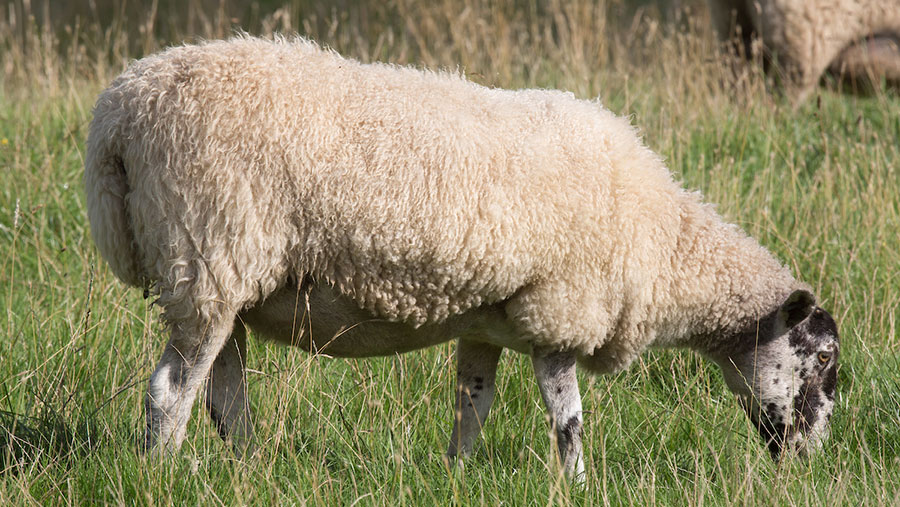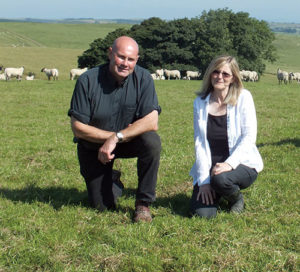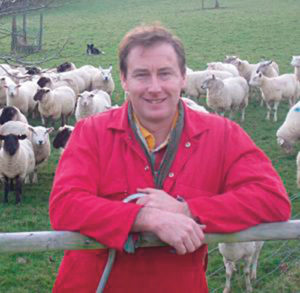Parasite Watch: What sheep worms are rife in your region?
 © Tim Scrivener
© Tim Scrivener Livestock farmers are being told not to judge parasite burdens by the calendar and instead take action to find out what is happening on their farm and in their area.
With warmer weather enabling a longer grazing season and milder winters leading to increased parasite survival, farmers need to have some degree of knowledge about parasites on their farm and in their locality.
See also: How a Cheshire farmer eradicated liver fluke from his flock
Monitor risks using Parasite Watch

John and Sarah Yeomans manage one of the farmers involved in Parasite Watch
Sheep farmer John Yeomans, Newtown, Wales, runs one of 18 farms involved in a Parasite Watch scheme run by Zoetis, now in its second year.
Farms involved in Parasite Watch will have faecal samples taken every two weeks, which will help detect major stomach worms and nematodirus, with results available within a couple of hours and uploaded to the Parasite Watch map at www.parasitewatch.co.uk.
Fluke will also be tested quarterly using coproantigen testing, which will pick up immature fluke at six weeks old, giving farmers the most advanced warning possible. Flies will be monitored on the farm using fly traps.
The aim of Parasite Watch is to inform the farmers involved in the project about parasite levels on their farm, but also alert producers to parasite risks in their local area.
Informed treatment
Mr Yeomans was involved in Parasite Watch last year and says as a result of monitoring growth rates and cross referencing with faecal egg counts (FEC), he had some sheep that didn’t require any drenching.
He farms 500 Beulah/Speckled Face ewes and 200 ewe lambs, lambing in Mid-March.
In mid-May, lambs are weighed before being turned on to the hill and are weighed at least every month thereafter until they are weaned in July.
“Last year if we had lambs that were growing 200g a day or less, we were taking faecal egg counts. In the main, those with lower growth rates had more of a challenge with worms,” he says.
Mr Yeomans also didn’t worm ewes in good condition at turnout last year. “I aim to leave at least 20% of ewes unwormed – so last year I had some ewes that weren’t wormed at all.”
Vet Dave Armstrong from Zoetis, says along with looking at risks in their area by using the Parasite Watch map, farmers should also be using FEC as a monitoring tool, as well as observing growth rates.
“If you are below your target growth rate, then that’s when you should start investigating.
“You can’t just judge by the calendar or what happened last year, you’ve got to look at stock, weigh stock and know what is going on.”
Preventing resistance

Peter Baber only treats with the results of faecal egg counts show that it is needed
Sheep farmer Peter Baber, who runs one of the 18 farms involved in Parasite Watch, believes long-term targeting of wormers has helped control the development of resistance on his farm.
He farms 1,000 Exlana, Suffolk and Texel ewes at Weir Park Farm, Christow, Exeter, and is also chairman of Sustainable Control of Parasites in Sheep (Scops).
He has been taking faecal egg counts for the past 10 years and will only worm if results indicate there is a problem.
Last year he was pleased to find the white BZ group of wormers worked 100% on his farm early in the season.
“It implies we don’t have blanket resistance to BZ’s, which is good news and could be an indication of how successful using faecal egg counts are.”
Mr Baber says drenching is a double-edged sword.
“Every time you drench you are essentially moving the whole farm down the road to resistance. You have to work out whether the group or animal in question is going to really benefit from the drench.”
He added that if he has a faecal egg count that comes back showing medium risk, he may go out and drench 20% of the flock. “It shows there are some worms there, so I will worm those animals most at risk.
“Taking faecal egg counts builds a picture of what is happening on farm and will help preserve the useful lifetime of some drenches,” he adds.
About Parasite Watch
The aim of Parasite Watch is to show what is happening across the UK using an interactive map found at www.parasitewatch.co.uk.
Parasite data from each of the farms will be updated regularly, which will allow farmers to see if there are spikes in certain parasites throughout the year in their area and enable them to take appropriate action.
Farmers Weekly will be updating readers monthly up until September on the results.
To use the map, click on a farm in your area and details of any parasites found as well as when they were detected will be displayed. Test results will be online within hours of the test being taken.
How to take a faecal sample for testing
Taking faecal egg counts can help highlight parasite risks, allowing farmers to make informed treatment decisions.
Dung samples can be analysed on-farm using a DIY kit, such as Fecpak, or dung samples can be sent away to specialist laboratories or vet practices.
Options for testing can be discussed with your vet.
Here’s a step-by-step guide on how to take a faecal sample.
See also: 10-step guide to taking a sheep faecal egg count
- Dung samples must be fresh (less than one hour old). Mob samples can be taken either by gathering sheep in the corner of a field for a few minutes, then picking up samples when they move, or carry pots/bags when out herding and take a sample as lambs get up.
- Samples must be kept cool (not frozen) in an airtight container or plastic bag, before examination or delivery to the laboratory within 48 hours.
- Sheep should be healthy and have had full access to pasture and/or feed before sampling otherwise the results will be difficult to interpret
- Each test must be based on at least 10 individual samples
- Samples can be sent for analysis to a suitably equipped and trained vet practice, a commercial service or adopt a DIY approach using the Fecpak system
- The results are presented as ‘eggs per gram’ (epg) of faeces. The number of eggs is an indication of the number of adult worms in the gut of the sheep. Scops says as a guide, less than 250 eggs/g is low risk; 250-750 eggs/g is medium risk and more than 750 is high risk.
Source: Sustainable Control of Parasites in Sheep
